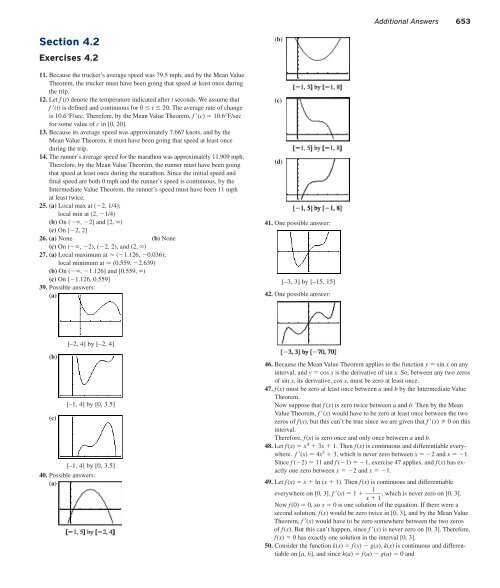5128_ch04ansTE_pp652-661
Create successful ePaper yourself
Turn your PDF publications into a flip-book with our unique Google optimized e-Paper software.
Additional Answers 653<br />
Section 4.2<br />
Exercises 4.2<br />
11. Because the trucker’s average speed was 79.5 mph, and by the Mean Value<br />
Theorem, the trucker must have been going that speed at least once during<br />
the trip.<br />
12. Let f (t) denote the temperature indicated after t seconds. We assume that<br />
f (t) is defined and continuous for 0 t 20. The average rate of change<br />
is 10.6°F/sec. Therefore, by the Mean Value Theorem, f (c) 10.6°F/sec<br />
for some value of c in [0, 20].<br />
13. Because its average speed was approximately 7.667 knots, and by the<br />
Mean Value Theorem, it must have been going that speed at least once<br />
during the trip.<br />
14. The runner’s average speed for the marathon was approximately 11.909 mph.<br />
Therefore, by the Mean Value Theorem, the runner must have been going<br />
that speed at least once during the marathon. Since the initial speed and<br />
final speed are both 0 mph and the runner’s speed is continuous, by the<br />
Intermediate Value Theorem, the runner’s speed must have been 11 mph<br />
at least twice.<br />
25. (a) Local max at (2, 1/4);<br />
local min at (2, 1/4)<br />
(b) On (, 2] and [2, )<br />
(c) On [2, 2]<br />
26. (a) None (b) None<br />
(c) On (, 2), (2, 2), and (2, )<br />
27. (a) Local maximum at (1.126, 0.036);<br />
local minimum at (0.559, 2.639)<br />
(b) On (, 1.126] and [0.559, )<br />
(c) On [1.126, 0.559]<br />
39. Possible answers:<br />
(a)<br />
(b)<br />
(c)<br />
(d)<br />
41. One possible answer:<br />
[–3, 3] by [–15, 15]<br />
42. One possible answer:<br />
[–2, 4] by [–2, 4]<br />
(b)<br />
(c)<br />
[–1, 4] by [0, 3.5]<br />
[–1, 4] by [0, 3.5]<br />
40. Possible answers:<br />
(a)<br />
46. Because the Mean Value Theorem applies to the function y sin x on any<br />
interval, and y cos x is the derivative of sin x. So, between any two zeros<br />
of sin x, its derivative, cos x, must be zero at least once.<br />
47. f(x) must be zero at least once between a and b by the Intermediate Value<br />
Theorem.<br />
Now suppose that f (x) is zero twice between a and b. Then by the Mean<br />
Value Theorem, f (x) would have to be zero at least once between the two<br />
zeros of f(x), but this can’t be true since we are given that f (x) 0 on this<br />
interval.<br />
Therefore, f(x) is zero once and only once between a and b.<br />
48. Let f(x) x 4 3x 1. Then f(x) is continuous and differentiable everywhere.<br />
f (x) 4x 3 3, which is never zero between x 2 and x 1.<br />
Since f (2) 11 and f (1) 1, exercise 47 applies, and f(x) has exactly<br />
one zero between x 2 and x 1.<br />
49. Let f(x) x ln (x 1). Then f(x) is continuous and differentiable<br />
1<br />
everywhere on [0, 3]. f (x) 1 , which is never zero on [0, 3].<br />
x 1<br />
Now f(0) 0, so x 0 is one solution of the equation. If there were a<br />
second solution, f(x) would be zero twice in [0, 3], and by the Mean Value<br />
Theorem, f (x) would have to be zero somewhere between the two zeros<br />
of f(x). But this can’t happen, since f (x) is never zero on [0, 3]. Therefore,<br />
f(x) 0 has exactly one solution in the interval [0, 3].<br />
50. Consider the function k(x) f(x) g(x). k(x) is continuous and differentiable<br />
on [a, b], and since k(a) f(a) g(a) 0 and












